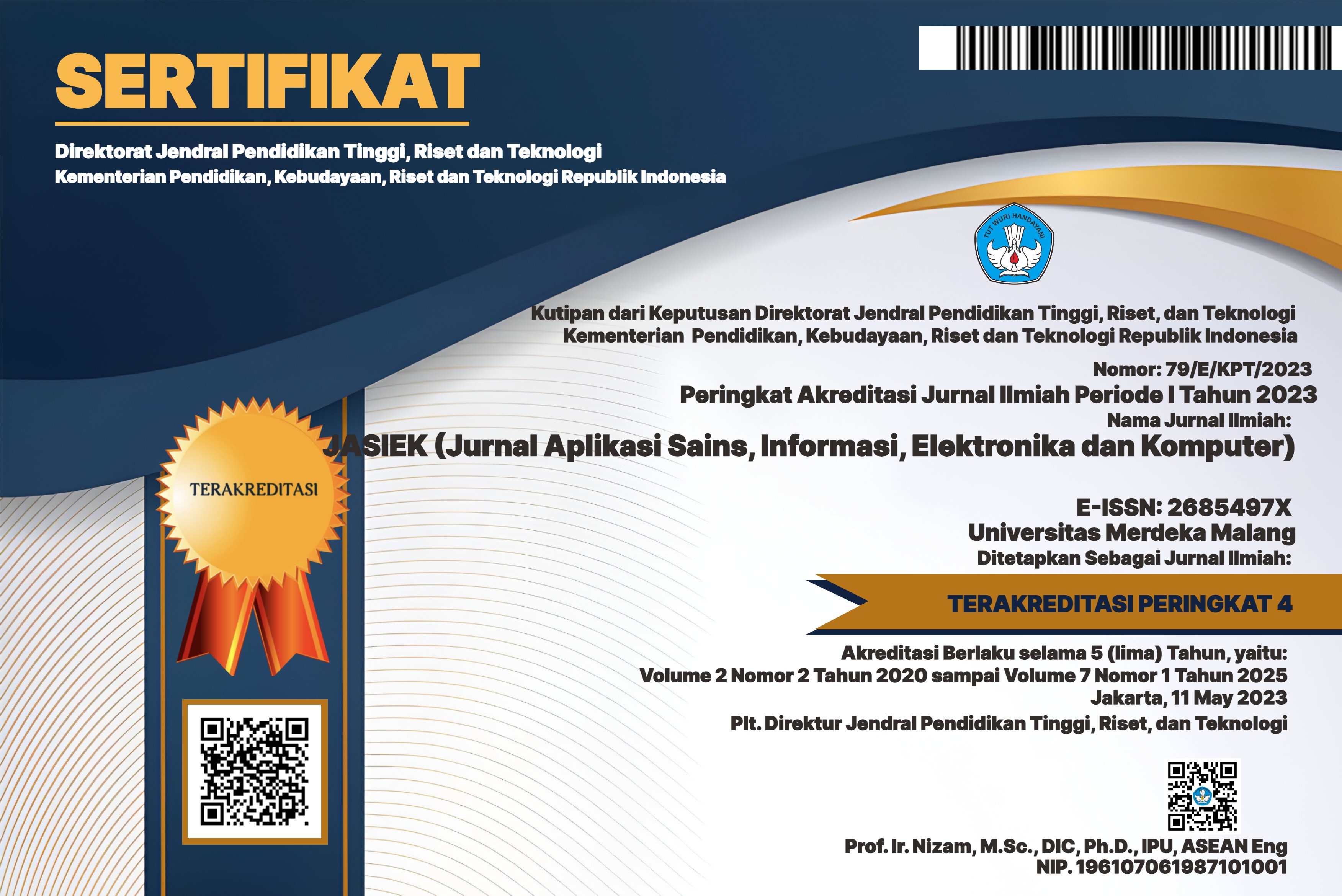Optimalisasi Deteksi Wajah Real-Time Menggunakan HAAR Cascade Classifier berbasis OpenCV
DOI:
https://doi.org/10.26905/jasiek.v7i1.15485Keywords:
Color Palette, Face detection, FPS performance improvement, HAAR Cascade Classifier, Real-timeAbstract
Nowadays, the face is one of the features that is widely used in various aspects of life such as security which includes access control and surveillance, biometrics which includes attendance systems, and many others. The obstacles found in implementing this are generally about speed performance when detecting, this is vital because if the process takes a long time, misconceptions and system errors will occur. HAAR Cascade Classifier is one of the most widely used lightweight face detection algorithms. In this research, by analyzing the use of grayscale color compared to RGB, a performance increase of 6.17% is obtained with an average FPS on RGB of 25.63 while on grayscale it is 27.21.
Downloads
References
[1] H. Bilal, B. Yin, J. Khan, L. Wang, J. Zhang, and A. Kumar, “Real-Time Lane Detection and Tracking for Advanced Driver Assistance Systems,” in 2019 Chinese Control Conference (CCC), pp. 6772–6777, Jul. 2019.
[2] D. Chand, S. Gupta, and I. Kavati, “Computer Vision based Accident Detection for Autonomous Vehicles,”, arXiv: arXiv:2012.10870, Dec. 20, 2020.
[3] D. Sari, A. R. Pratama, D. Pramadihanto, and B. S. Marta, “3D Object Detection Based on Point Cloud Data,” Inf. J. Ilm. Bid. Teknol. Inf. dan Komun., vol. 7, no. 1, pp. 59–66, Jun. 2022.
[4] A. R. Pratama, B. S. B. Dewantara, D. M. Sari, and D. Pramadihanto, “Density-based Clustering for 3D Stacked Pipe Object Recognition using Directly-given Point Cloud Data on Convolutional Neural Network,” EMITTER Int’l J. of Engin. Technol., pp. 153–169, Jun. 2022.
[5] A. R. Pratama, B. S. B. Dewantara, D. M. Sari, and D. Pramadihanto, “3D Object Pose Estimation Using Local Features Based for Industrial Appliance,” in 2023 International Electronics Symposium (IES), pp. 440–445, 2023.
[6] A. R. Pratama, B. S. B. Dewantara, D. M. Sari, and D. Pramadihanto, “Improvement of DBSCAN Algorithm Involving Automatic Parameters Estimation and Curvature Analysis in 3D Point Cloud of Piled Pipe,” JOIG, vol. 12, no. 2, pp. 175–185, 2024.
[7] J. Sang et al., “An Improved YOLOv2 for Vehicle Detection,” Sensors, vol. 18, no. 12, p. 4272, Dec. 2018.
[8] M. Tan, R. Pang, and Q. V. Le, “EfficientDet: Scalable and Efficient Object Detection,” in 2020 IEEE/CVF Conference on Computer Vision and Pattern Recognition (CVPR), pp. 10778–10787, Jun. 2020.
[9] I. A. Putri, D. A. Prasetya, and T. M. Fahrudin, “Image Classification Of Vine Leaf Diseases Using Complex-Valued Neural Network,” JIKO (Jurnal Informatika Dan Komputer), vol. 7, no. 1, pp. 36–42, Apr. 2024.
[10] M. Idhom, D. A. Prasetya, P. A. Riyantoko, T. M. Fahrudin, and A. P. Sari, “Pneumonia classification utilizing VGG-16 architecture and convolutional neural network algorithm for imbalanced datasets,” TIERS Information Technology Journal, vol. 4, no. 1, pp. 73–82, Jun. 2023.
[11] S. Yang, P. Luo, C. C. Loy, and X. Tang, “WIDER FACE: A Face Detection Benchmark,” in 2016 IEEE Conference on Computer Vision and Pattern Recognition (CVPR), pp. 5525–5533, 2016.
[12] D. A. Permatasari, H. Herwandi, D. S. Ma’arif, and A. Ramelan, “Rancang Bangun Alat Sistem Absensi Mahasiswa menggunakan Face Recognition dengan Metode YOLO berbasis Raspberry Pi,” Jurnal Aplikasi Sains, Informasi, Elektronika dan Komputer (JASIEK), vol. 6, no. 2, pp. 114-124, 2024.
[13] F. Schroff, D. Kalenichenko, and J. Philbin, “FaceNet: A unified embedding for face recognition and clustering,” in 2015 IEEE Conference on Computer Vision and Pattern Recognition (CVPR), pp. 815–823, Jun. 2015.
[14] J. Deng, J. Guo, J. Yang, N. Xue, I. Kotsia, and S. Zafeiriou, “ArcFace: Additive Angular Margin Loss for Deep Face Recognition,” IEEE Trans. Pattern Anal. Mach. Intell., vol. 44, no. 10, pp. 5962–5979, Oct. 2022.
[15] M. Najibi, B. Singh, and L. S. Davis, “FA-RPN: Floating Region Proposals for Face Detection,” in 2019 IEEE/CVF Conference on Computer Vision and Pattern Recognition (CVPR), Jun. 2019.
[16] S. A. Sanchez, H. J. Romero, and A. D. Morales, “A review: Comparison of performance metrics of pretrained models for object detection using the TensorFlow framework,” in IOP Conf. Ser.: Mater. Sci. Eng., vol. 844, Jun. 2020.
[17] L. Cuimei, Q. Zhiliang, J. Nan, and W. Jianhua, “Human face detection algorithm via Haar Cascade Classifier combined with three additional classifiers,” in 2017 13th IEEE International Conference on Electronic Measurement & Instruments (ICEMI), pp. 483–487, Oct. 2017.
[18] D. A. A. Ayubi, D. A. Prasetya, and I. Mujahidin, “Haar Cascade Classifier Method for Real Time Face Detector In 2 Degree of Freedom (DoF) Robot Head,” in Proceedings of the 2nd Faculty of Industrial Technology International Congress, 2020.
[19] Y. Malo, W. Dirgantara, dan S. Subairi, "Implementasi Pengenalan Wajah dengan Metode Haar Cascade Classifier pada Akses Boarding House," Aviation Electronics, Information Technology, Telecommunications, Electricals, and Controls (AVITEC), vol. 5, no. 2, pp. 75–85, Aug. 2023
[20] G. Bradski, ‘The OpenCV Library’, Dr. Dobb’s Journal of Software Tools, 2000.
Downloads
Published
Issue
Section
License
Copyright (c) 2025 JASIEK (Jurnal Aplikasi Sains, Informasi, Elektronika dan Komputer)

This work is licensed under a Creative Commons Attribution-NonCommercial-ShareAlike 4.0 International License.
Authors who publish with this journal agree to the following terms:
The journal allow the authors to hold the copyright without restrictions and allow the authors to retain publishing rights without restrictions.
Authors retain copyright and grant the journal right of first publication with the work simultaneously licensed under a Creative Commons Attribution-ShareAlike 4.0 International License that allows others to share the work with an acknowledgement of the work's authorship and initial publication in this journal.
Authors are able to enter into separate, additional contractual arrangements for the non-exclusive distribution of the journal's published version of the work (e.g., post it to an institutional repository or publish it in a book), with an acknowledgement of its initial publication in this journal.
Authors are permitted and encouraged to post their work online (e.g., in institutional repositories or on their website) prior to and during the submission process, as it can lead to productive exchanges, as well as earlier and greater citation of published work (See The Effect of Open Access).

This work is licensed under a Creative Commons Attribution-ShareAlike 4.0 International License.










